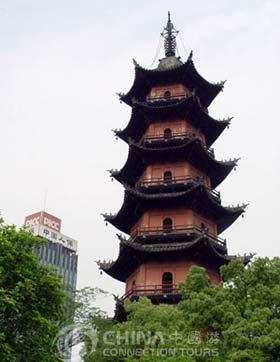 Tianfeng Pagoda was first built in the Tang Dynasty (695A.D.), rebuilt in 1144 of the South Song and undergone repeated repairs in later times, and located in the center of Ningbo. After the latest repair done in 1984, it is well preserved as a Song-Dynasty-style half-timber pagoda pavilion in shape. It is a typical Song-Dynasty-style half-timber pagoda in the South of the Yangtze River, featured for exquisiteness, simplicity and solemness and used to be a navigation mark for the port of Mingzhou in ancient times and an important landmark structure of Ningbo City in modern times, thus a large amount of cultural relics still can be found in the pagoda today.
Tianfeng Pagoda was first built in the Tang Dynasty (695A.D.), rebuilt in 1144 of the South Song and undergone repeated repairs in later times, and located in the center of Ningbo. After the latest repair done in 1984, it is well preserved as a Song-Dynasty-style half-timber pagoda pavilion in shape. It is a typical Song-Dynasty-style half-timber pagoda in the South of the Yangtze River, featured for exquisiteness, simplicity and solemness and used to be a navigation mark for the port of Mingzhou in ancient times and an important landmark structure of Ningbo City in modern times, thus a large amount of cultural relics still can be found in the pagoda today.
Tianfeng Pagoda was so named because it was constructed during the reign of Wu Zetian the Empress of Tang Dynasty when she was enthroned ("Tianfeng" in Chinese means "enthronement under the will of Heaven"). The original pagoda was hexagonal in shape and about 51 meters high. A story goes that during construction of the pagoda, sand was piled up for ease of operation, and as a result, large amount of sand and mud was left over (that is why the Dashani (Big Sand and Mud) Street and the Xiaoshani (Small Sand and Mud) Street acquired their present names.
Local people regarded the pagoda a holy tower patronizing the prefecture. The pagoda was once used as a beacon tower in wars. And in peaceful days, bright lanterns were lit on the top of the pagoda, lighting up paths for boats and pedestrians. The pagoda was destroyed by the war during 1128 and 1130, and was rebuilt in 1144.
It was a thirteen-story pagoda. The outer skirts, platform and baluster of the pagoda were destroyed by fire in 1798, and were rebuilt in 1935. A bronze dagoba made by Qian Hongshu, King of Wuyue in the Five-dynasty period, was found on the top of the pagoda during maintenance work in 1957; the dagoba bears the inscribed year of 955.
'Underground Palace' was found when an inspection was conducted upon the foundation of the pagoda in 1982, and silver ingots, silver pagodas and the like were unearthed; the year inscribed on the 'Underground Palace' as well as on the stone case found was 'the 14th year of Shaoxing Reign of Song Dynasty'.
The unearthed bronze coins dated the latest were the coins marked with "Yuanbao Reign of Song Dynasty", which conformed with the literature saying the pagoda was destroyed by war during the reign of Emperor Jianyan of Song Dynasty, and was rebuilt by Monk Dehua during the Shaoxing Reign'. In 1984, the pagoda tilted severely, and crevices were found on the wall.
The body of pagoda was pulled down for a thorough repair, and was found to measure 42.5 meters high; hundreds pieces of artifacts dating back to Song or Yuan dynasty like seals, bricks and classic religious scriptures were found inside the pagoda. The repair work started from September 1987 and lasted till November 4, 1987, with RMB1,600,000 spent.
The renovated pagoda measures 51.5 meters high (decorations on the pagoda top inclusive), and has 7 grades of outer skirts tilting upwards splendidly. On each skirt are the cloisters well protected by balusters. The body of the pagoda is dark red, and the outer skirts black, offering an air of simple and classic loftiness.
Tianfeng Pagoda was listed among the key historic site under municipal protection in May 1961 and in December 1981.
